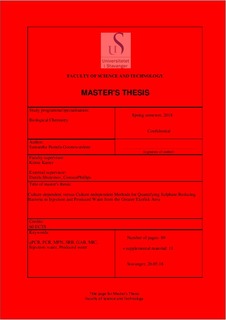| dc.description.abstract | Planktonic and sessile bacteria, in particular sulphate-reducing bacteria (SRB), in the petroleum industry can be damaging to top-side facilities, pipelines and reservoirs. Development of microbial influenced corrosion (MIC), loss of production through reservoir souring, generation of H2S gas and degradation of petroleum products, are some of the main concerns, due to the growth of deleterious microorganisms. These problems can be reduced through appropriate bacteriological monitoring and management.
This study has compared the culture-dependent most probable number (MPN) method with the culture-independent quantitative PCR (qPCR) method, for quantifying SRB in injection and produced water from the Greater Ekofisk Area. Further, a qPCR protocol for absolute quantification of SRB was developed. In addition, detection of general aerobic bacteria (GAB) was performed using MPN. Injection and produced water samples were taken over a period of 7 months from the offshore installations Eldfisk 2/7B, Eldfisk 2/7E, Ekofisk 2/4VB and Ekofisk 2/4J.
The final standard curve used for quantification was developed with plasmid DNA containing the PCR insert of the dissimilatory sulphite reductase B (dsrB) gene from produced water. SRB was detected by qPCR using dsrB specific primers and the limit of detection (LOD) was 10^3 dsrB copies/µl. qPCR quantified SRB in both injection (10^5-10^6 copies/µl) and produced water (10^7-10^8 copies/µl). SRB was not detected by MPN, whereas GAB was detected in both injection and produced water.
Results in this study documents that qPCR is more suitable for detection and quantification of SRB compared to the MPN method and could be beneficial for application at Ekofisk. With the developed qPCR assay, quantitative and objective bacteriological results at Ekofisk can be obtained within a few hours, rather than 30 days as with the MPN method currently applied. Injection water from Ekofisk 2/4VB indicates higher bacterial numbers, and measures should be taken to reduce the microbial flora, to further prevent MIC. Except for Ekofisk 2/4VB, other sampling locations for injection water did not show any signs of bacterial growth, indicating a highly efficient injection water treatment system. | nb_NO |
